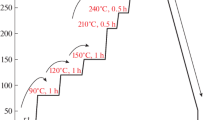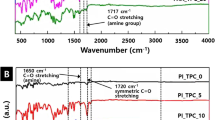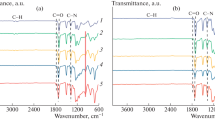Abstract
A series of intrinsically black polyimide (PI) films have been designed and synthesized by the copolymerization of pyromellitic dianhydride (PMDA), 4,4′-oxydianiline (ODA) and 4,4′-diaminodiphenylamine (NDA) via a two-step polycondensation procedure, followed by the high temperature imidization reaction of the poly(amic acid) (PAA) intermediates. Incorporation of the electron-rich NDA diamine apparently enhanced the formation of charge transfer complex (CTC) between the electron-donating diamine units and the electron-accepting dianhydride moiety; thus greatly absorbing the visible light and endowing the derived PI films deep colors. PI-5 with the 100% molar ratio of NDA in the diamines exhibited a cutoff wavelength value of 555 nm, which was 127 nm higher than that of PI-1 without NDA component. The PI films were nearly totally opaque at the wavelength of 500 nm when the molar ratio of NDA exceeded 80% in the diamines. PI-5 showed International Commission on Illumination (CIE) lab color parameters of 23.36 for L*, 46.43 for a*, and 40.26 for b*, indicating the essentially black plus red color instead of the yellow plus blue color for PI-1 film (L* = 89.93, a* = −11.09, and b* = 84.23). In addition, introduction of NDA into the copolymer films increased the high temperature dimensional stability of the films. PI-5 exhibited a glass transition temperature (Tg) and coefficient of thermal expansion (CTE) of 431.6 °C and 18.8 × 10−6 /K, respectively, which were superior to those of the PI-1 film (Tg = 418.8 °C, CTE = 29.5 × 10−6 /K). At last, incorporation of NDA components somewhat decreased the tensile properties and thermal decomposition temperatures of the PI films.














Similar content being viewed by others
References
Liaw DJ, Wang KL, Huang YC, Lee KR, Lai JY, Ha CS (2012) Advanced polyimide materials: Syntheses, physical properties and applications. Prog Polym Sci 37:907–974
Sazanov YN (2001). Russ J Appl Chem 74:1253–1269
Tsai CL, Yen HJ, Liou GS (2016) Highly transparent polyimide hybrids for optoelectronic applications. Reac Func Polym 108:2–30
Choi MC, Wakita J, Ha CS, Ando S (2009) Highly Transparent and Refractive Polyimides with Controlled Molecular Structure by Chlorine Side Groups. Macromolecules 42:5112–5120
Ando S, Matsuura T, Sasaki S (1997) Coloration of Aromatic Polyimides and Electronic Properties of Their Source Materials. Polym J 29:69–76
Ke FY, Song NH, Liang DH, Xu HY (2013) A method to break charge transfer complex of polyimide: A study on solution behavior. J Appl Polym Sci 127:797–803
Chen GF, Pei XL, Liu JT, Fang XZ (2013) Synthesis and properties of transparent polyimides derived from trans- and cis-1,4-bis(3,4-dicarboxyphenoxy)cyclohexane dianhydrides. J Polym Res 20:159
Damaceanu MD, Constantin CP, Bruma M, Belomoina NM (2014) Highly fluorinated polyimide blends – Insights into physico-chemical characterization. Polymer 55:4488–4497
Ni HJ, Liu JG, Wang ZH, Yang SY (2015) A review on colorless and optically transparent polyimide films: Chemistry, process and engineering applications. J Ind Eng Chem 28:16–27
Matzumoto T, Mikami D, Hashimoto T, Kaise M, Takahashi R, Kawabata S (2009) Alicyclic polyimides – a colorless and thermally stable polymer for opto-electronic devices. J Phys Conf Ser 187:012005
Takizawa K, Wakita J, Azami S, Ando S (2011) Relationship between Molecular Aggregation Structures and Optical Properties of Polyimide Films Analyzed by Synchrotron Wide-Angle X-ray Diffraction, Infrared Absorption, and UV/Visible Absorption Spectroscopy at Very High Pressure. Macromolecules 44:349–359
Hu XF, Mu HL, Wang YX, Wang Z, Yan JL (2018) Colorless polyimides derived from isomeric dicyclohexyl-tetracarboxylic dianhydrides for optoelectronic applications. Polymer 134:8–19
Hasegawa M, Horie K (2001) Photophysics, photochemistry, and optical properties of polyimides. Prog Polym Sci 26:259–335
Romyen N, Thongyai S, Praserthdam P (2010) Surfactant-dispersed carbon black in polyimide nanocomposites: Spectroscopic monitoring of the dispersion state in the polymer matrix. J Appl Polym Sci 115:1622–1629
Zhang QQ, Xu Y, Yang Y, Li LS, Song CR, Su X (2018) Conductive mechanism of carbon black/polyimide composite films. J Polym Eng 38:147–156
Jiang XW, Bin YZ, Matsuo M (2005) Electrical and mechanical properties of polyimide–carbon nanotubes composites fabricated by in situ polymerization. Polymer 46:7418–7424
Xue PF, Bao KB, Li QY, Wu CF (2010) Impact of modification of carbon black on morphology and performance of polyimide/carbon black hybrid composites. Phys Chem Chem Phys 12:11342–11350
Lin JS, Chiu HT (2002). J Polym Res 9:189–194
Atar N, Grossman E, Gouzman I, Bolker A, Murray VJ, Marshall BC, Qian M, Minton TK, Hanein Y (2015) Atomic-Oxygen-Durable and Electrically-Conductive CNT-POSS-Polyimide Flexible Films for Space Applications. ACS Appl Mater Interfaces 7:12047–12056
Kwon J, Kim J, Lee J, Han P, Park D, Han H (2014) Fabrication of polyimide composite films based on carbon black for high-temperature resistance. Polym Compos 35:2214–2220
Chen CJ, Yen HJ, Hu YC, Liou GS (2013) Novel programmable functional polyimides: preparation, mechanism of CT induced memory, and ambipolar electrochromic behavior. J Mater Chem C 1:7623–7634
Hu YC, Chen CJ, Yen HJ, Lin KY, Yeh JM, Chen WC, Liou GS (2012) Novel triphenylamine-containing ambipolar polyimides with pendant anthraquinone moiety for polymeric memory device, electrochromic and gas separation applications. J Mater Chem 22:20394–20402
Yen HJ, Liou GS (2012) Solution-processable triarylamine-based electroactive high performance polymers for anodically electrochromic applications. Polym Chem 3:255–264
Kulszewicz-Bajer I, Rozalska I, Kurylek M (2004) Synthesis and spectroscopic properties of aniline tetramers. Comparative studies. New J Chem 28:669–675
Baldevbhai PJ, Anand RS (2012) Color Image Segmentation for Medical Images using L*a*b* Color Space. IOSR J Electron Commun Eng 1(2):24–45
Becerir B (2017). J Textile Eng Fashion Technol 1(6):240–244
Acknowledgements
Financial support from the Fundamental Research Funds of China University of Geosciences (No. 2652017345) is gratefully acknowledged.
Author information
Authors and Affiliations
Corresponding authors
Additional information
Publisher’s note
Springer Nature remains neutral with regard to jurisdictional claims in published maps and institutional affiliations.
Rights and permissions
About this article
Cite this article
Zhang, Y., Tan, Yy., Liu, Jg. et al. Molecular design, synthesis and characterization of intrinsically black polyimide films with high thermal stability and good electrical properties. J Polym Res 26, 171 (2019). https://doi.org/10.1007/s10965-019-1835-0
Received:
Accepted:
Published:
DOI: https://doi.org/10.1007/s10965-019-1835-0




